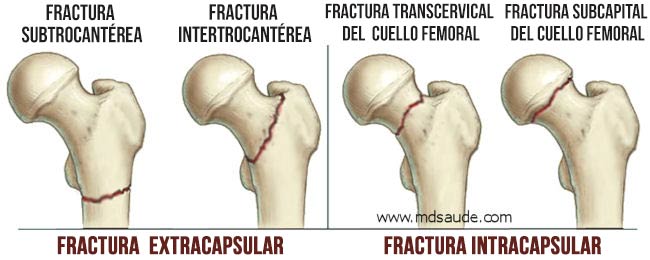Recent Posts
Powered by Damos Soluciones

Older people are more likely to suffer a hip fracture, especially if they have diseases such as Osteoporosis, but it is not exclusive to this type of people. If a young person suffers a high-energy impact such as a car accident or a fall from a considerable height, they may suffer a fracture. Although it is much more frequent in the former due to the high frequency of presentation of Bone Fragility.
Fractures are divided into two main types:
Intracapsular Fracture: They occur in the femoral head or neck.
Extracapsular Fracture (Intertrochanteric): It occurs just below the neck of the femur, where there is a wider area that includes the lesser trochanter of the femur.

Symptoms:
In most cases, when a person suffers a hip fracture, they lose the ability to support the limb and walk, they feel a very strong pain in the hip or groin that in some cases can radiate to the knee because they share nerve endings. If there is a lot of internal bleeding, bruising can occur in the hip area and when lying in a resting position, one leg appears shorter than the other and is turned outward.
Driving:
Management is generally surgical to seek to ensure that the patient returns as soon as possible to their ability to walk and has a better quality of life. There are different options to achieve a successful consolidation and rehabilitation, your choice depends on the type of fracture, the patient's age, the patient's bone density and whether or not there are other underlying diseases.
Osteosynthesis:
Metal implants or screws are inserted and, in some cases, are attached to a metal plate in the bone to hold it together while the fracture heals.
.jpg)
Partial hip replacement:
Only the femoral head is replaced through a stem that is fixed to the femur, this prosthesis articulates directly with the patient's acetabulum.
.jpg)
Total hip replacement:
The surfaces that make up the hip joint are completely removed, both the femoral head and femoral neck and the articular surface of the acetabulum, in its place an acetabular implant called a cup, and a femoral stem are implanted.
After surgery, the patient must start physiotherapeutic work. Initially, it will focus on exercises that help maintain range of motion and regain gait, after which it will be based on strengthening the muscles around the joint. In many cases the support of a cane, crutches or walker will be needed to aid in recovery, this is determined by the doctor in conjunction with the physical therapist.
Image 1 taken from: https://drranatvishnoi.com/
Image 2 taken from: https://viewmedica.com/